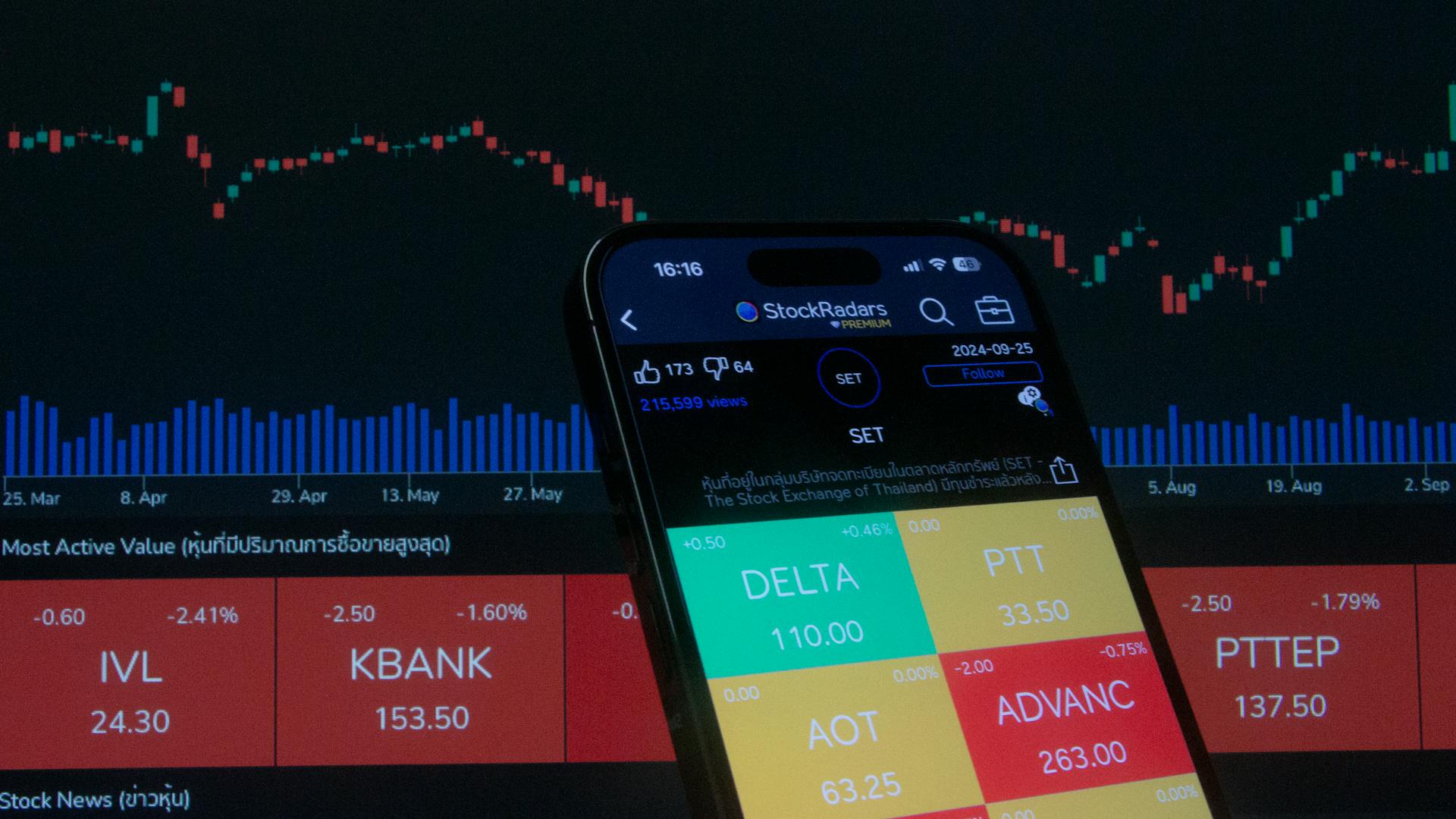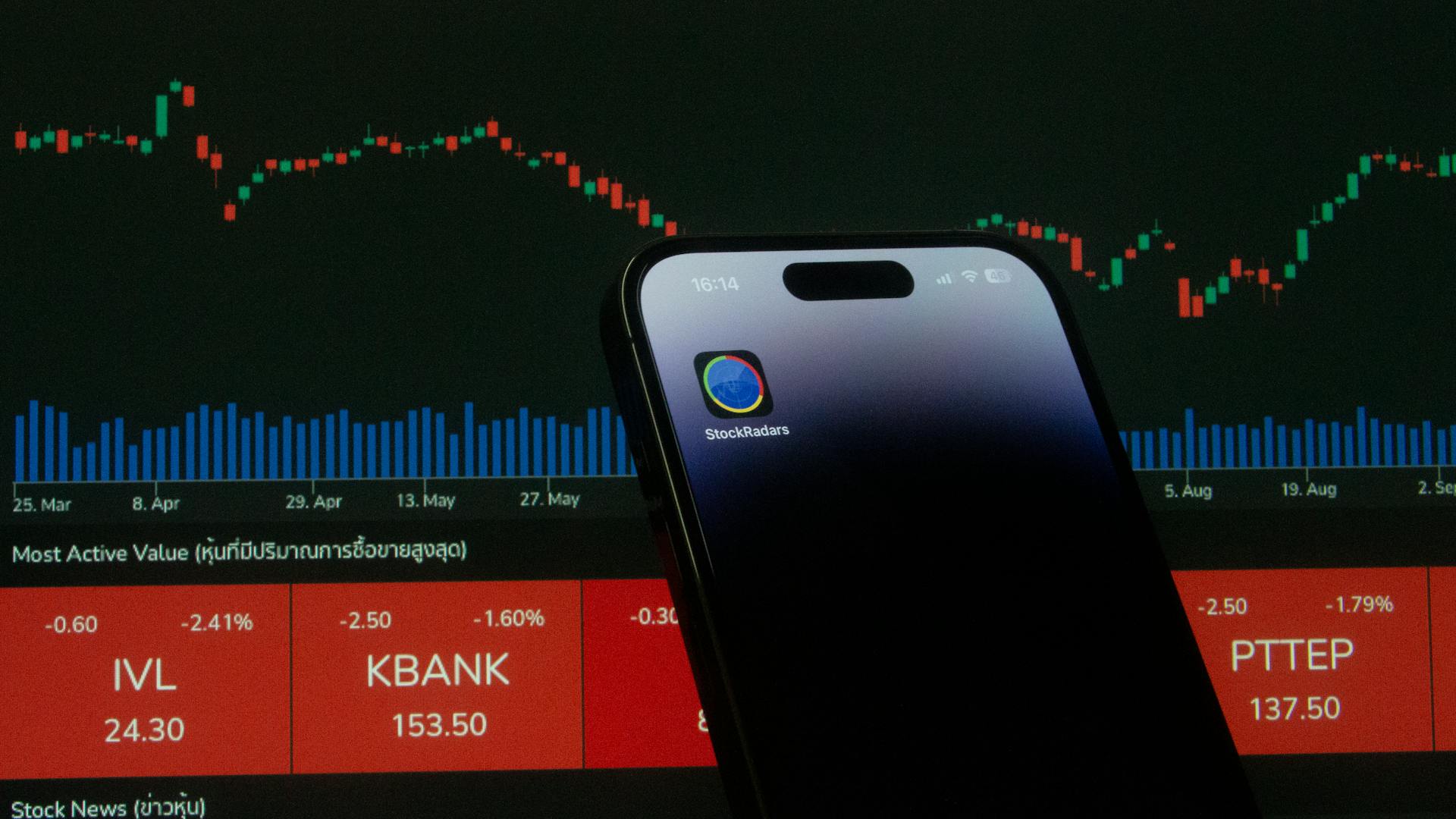
Jesse Livermore's life was a rollercoaster of ups and downs, marked by incredible speculation and success.
He started trading at just 14 years old, making his first profit by selling short on a stock that he believed was overvalued. This early experience laid the foundation for his future trading career.
Livermore's big break came in 1906 when he made a $100,000 profit, a staggering amount at the time, by short-selling stocks that he believed would decline in value. This success caught the attention of the financial community and set him on the path to becoming one of the most famous traders of his time.
He was known for his bold and often contrarian approach to trading, which sometimes got him into trouble but also led to significant gains.
A fresh viewpoint: What Does Trading Stocks Mean
Investing Principles and Strategies
Jesse Livermore's investing principles and strategies were built on a foundation of technical analysis, market psychology, and a deep understanding of crowd behavior. He emphasized the importance of timing in trading and waiting for the right market conditions.
Livermore believed that markets are never wrong, but opinions often are. He advocated for letting profits run and cutting losses quickly, and for never risking more than a small percentage of trading capital on a single trade.
One of Livermore's key principles was to let the market give the signal before taking action. He believed that anticipating the market is to gamble, but being patient and reacting only when the market gives the signal is to speculate.
Livermore also stressed the importance of discipline and emotional control in trading. He advised traders to never lose their temper over the stock market and never argue with the tape.
Livermore's strategies were based on the supposition that people will continue to make the mistakes they have made in the past. He believed that there is nothing like losing all you have in the world for teaching you what not to do, and that once you know what not to do, you begin to learn what to do.
Livermore's famous "pivotal points" strategy involved identifying critical price levels where stocks are likely to make significant moves. He emphasized the importance of reading stock charts and using them to make informed trading decisions.
You might like: Stocks Trading

Livermore's approach to analyzing market behavior and anticipating future movements was rooted in his deep understanding of market mechanics. He advised traders to always protect their capital by using stop-loss orders and to never risk more than a small percentage of their trading capital on a single trade.
In summary, Livermore's investing principles and strategies were centered around timing, psychology, and money management. He emphasized the importance of discipline, emotional control, and patience in trading, and advised traders to always protect their capital and never risk too much on a single trade.
Related reading: Steve Cohen Trading Stocks
Career and Legacy
Jesse Livermore's career was marked by incredible highs and lows. He was the world's richest man at one time, but his liability surpassed his assets upon his death.
At just 14, Livermore dropped out of school to work on his father's farm, but he soon ran away to pursue a career in trading. By 15, he was making a profit of $3.12 on a $5 bet, earning him the nickname "The Boy Plunger."
Livermore's early success was fueled by his ability to read and write at the age of 3, and he went on to make a net profit of $10,000 between 1895 and 1897, a 1000% return in just three years of trading.
Early Life and Education

Jesse Livermore was born on July 26, 1877, in Shrewsbury, Massachusetts.
He learned how to read and write at the age of 3, which is quite impressive.
At 14, he dropped out of school to work on his father's farm, but he didn't stay there for long.
He was employed as a board boy at the MA branch of Paine Webber stock brokerage in Boston, earning $5 per week.
By the age of 15, he made $3.12 on a $5 bet he made on Chicago, Burlington, and Quincy Railroad in a bucket shop.
He earned close to $200 per week, trading at the bucket shops in Boston, more than what he was paid at Paine Webber.
Livermore was nicknamed “The Boy Plunger” due to his aggressive trading style, which started at a young age.
At 16, he resigned from his low-paying job and started trading full-time.
Personal Life
Jesse Livermore's personal life was marked by turmoil, with multiple marriages and relationships that were often strained. He married his first wife, Nettie Jordan, when he was just 23 years old, but their marriage ended in divorce less than a year later.

Livermore's first marriage was a tumultuous one, with Nettie refusing to pawn her jewelry to help him recover from bad trades. This led to a permanent strain in their relationship, and they soon separated.
After his divorce from Nettie, Livermore married Dorothea Fox Wendt, a former Ziegfeld girl, when he was 40 years old. They had a son, Jesse Livermore II, but their marriage ended in divorce as well.
Dorothy, Livermore's second wife, was granted a divorce and received a $10 million settlement, which she used to buy a new home. However, she later sold the house for significantly less than Livermore had spent on it, which depressed him.
Livermore's third marriage, to Harriet Metz Noble, was his longest-lasting one, lasting from 1931 until his death. They met in 1931 in Vienna, and Harriet was 38 years old at the time of their marriage.
Intriguing read: Select One Way That Common Stock Differs from Preferred Stock
Career
Jesse Livermore started trading full-time at the age of 16, after resigning from his low-paying job at a stock brokerage firm.

He made a net profit of $10,000 in just three years, a 1000% return on investment, between 1895 and 1897. This impressive feat earned him the nickname "The Boy Plunger".
At the age of 23, Livermore moved to New York and turned $10,000 into $50,000 in just five days through a long position at Harris, Hutton & Company Stockbroker.
Livermore's first great win was in 1901, when he made $500,000 from his initial $10,000 investment by going long on Northern Pacific Railway.
He was known for predicting market drops and was dubbed "the Bear of Wall Street" for his ability to anticipate market downturns.
For your interest: A Trader Wants to Hedge a Long Stock
Legacy in Modern Trading
Jesse Livermore's influence on modern trading is immense. His emphasis on technical analysis, trend-following, and risk management has shaped the strategies of countless market participants.
Many successful hedge fund managers and traders draw inspiration from Livermore's timeless principles, adapting them to contemporary markets and evolving technology. His legacy is a testament to the enduring allure and challenges of the financial markets.
You might like: Edward Thorp a Man for All Markets

Livermore's ability to navigate the complexities of speculation, coupled with his insight into market psychology, has left an indelible mark on the world of trading. His story is a captivating journey through the highs and lows of the stock market.
His two noted trades occurred during the Panic of 1907 and at the start of the Great Depression, earning him the nickname “the Bear of Wall Street.” He predicted market drops with remarkable accuracy, making him a legendary figure in the financial world.
Livermore's book, "How to Trade in Stocks", provides a comprehensive guide to trading, including his famous "pivotal points" strategy, which involves identifying critical price levels where stocks are likely to make significant moves. His insights into the importance of timing, psychology, and money management remain highly relevant and applicable today.
Despite being written over eight decades ago, the book's core principles of timing, psychology, and money management remain highly relevant and applicable. His legacy as one of the greatest traders of all time is cemented in this book.
You might enjoy: The Little Book That Still Beats the Market Joel Greenblatt
Influences and Events

J.P. Morgan's influence on Jesse L. Livermore was significant, as he urged Livermore to close his shorts during the panic of 1907 to benefit the country.
Livermore made $1 million on short positions in one day, but Morgan's pressure led him to close his positions, and he then netted an additional $3 million on the market rebound.
Livermore's willingness to close his shorts at Morgan's urging highlights the immense pressure traders faced during this time period.
If this caught your attention, see: Peter S Lynch
Who Did Influence?
Jesse Livermore's influence extended beyond his own trading career. He made $1 million on short positions in one day during the panic of 1907, and then netted an additional $3 million on the market rebound after J.P. Morgan urged him to close his shorts.
Many in the market know Jesse Livermore from the pseudonymous Twitter account of the same name, where his strategies are discussed and advised. This shows the enduring popularity and relevance of his methods.

Traders and investors continue to study Livermore's methods, learning from his successes and failures. His emphasis on technical analysis, trend-following, and risk management has shaped the strategies of countless market participants.
The modern concept of trend following and momentum investing owes a debt to Livermore's timeless principles. Many successful hedge fund managers and traders draw inspiration from his work.
Jesse Livermore's legacy is a testament to the power of studying and learning from others. His story offers valuable lessons for aspiring traders and investors.
You might like: How Are Stock Speculators Different from Stock Investors
How the White House Affects Trading
The White House can have a significant impact on trading, as we saw with Jesse L. Livermore's experience.
President Woodrow Wilson petitioned Livermore to sell his strong position in cotton after World War I to avoid harming the U.S. economy.
This highlights the power that government officials can wield over the markets, even in the absence of regulation.
Livermore's position was so large that it threatened to disrupt the entire U.S. cotton market, prompting Wilson's intervention.
The Great Crash

The Great Crash was a pivotal moment in Jesse Livermore's life and career as a stock trader.
He had made a fortune short-selling stocks in 1906 and 1907, but his luck changed in 1907 when he lost a significant amount of money due to a series of bad trades.
Livermore's downfall began in 1907, when he became overly optimistic and started buying stocks again, only to see them plummet in value.
He was heavily invested in the stock market when the Panic of 1907 occurred, causing widespread financial panic and a sharp decline in stock prices.
Livermore's losses were exacerbated by his failure to adapt to the changing market conditions and his refusal to cut his losses.
He eventually lost an estimated $3 million to $4 million in today's dollars, which was a staggering amount at the time.
Publications and Reminiscences
Jesse Livermore's writing career kicked off in 1940 with the publication of "How to Trade in Stocks", a book that was met with mixed reviews due to its controversial investment methods. The book's poor timing, coinciding with the onset of World War II, didn't help its sales.
For more insights, see: Timothy Sykes Book

The book was published by Duell, Sloan and Pearce in March 1940, and its reception was lukewarm. Despite its lackluster performance, "How to Trade in Stocks" remains an important part of Livermore's legacy.
In contrast, "Reminiscences of a Stock Operator" by Edwin Lefèvre, a book that offers a fictionalized account of Livermore's life, has stood the test of time, remaining a must-read for traders and investors nearly a century after its publication in 1923.
For more insights, see: Jesse Livermore Book
Reminiscences of a Stock Operator
"Reminiscences of a Stock Operator" is a timeless classic that offers a captivating insight into the world of stock trading.
First published in 1923, this book remains a must-read for both seasoned investors and those new to the stock market.
It presents a fictionalized account of the life of Jesse Livermore, one of the most famous traders in history, through the eyes of its protagonist, Larry Livingston.
The book chronicles Livingston's journey from his humble beginnings as a young boy trading stocks in bucket shops to his rise as a Wall Street legend.

A standout aspect of the book is its focus on the psychological elements of trading, highlighting the importance of discipline, patience, and the ability to manage emotions.
Livingston's experiences underscore the critical importance of risk management, with significant losses often due to over-leverage or failure to adhere to his own rules.
The concept of cutting losses and letting profits run is a recurring lesson throughout the book.
The protagonist's ability to adapt to changing market conditions is a key theme, illustrating the necessity of evolving one's strategies in response to the market environment.
"Reminiscences of a Stock Operator" is a seminal work that continues to resonate with traders and investors nearly a century after its publication.
Edwin Lefèvre's portrayal of Jesse Livermore's life offers timeless lessons in trading psychology, risk management, and market mechanics.
Worth a look: Soros Fund Management
Publications
Jesse Livermore's son suggested he write a book about trading in late 1939.
The book, How to Trade in Stocks, was published by Duell, Sloan and Pearce in March 1940.
It didn't sell well due to World War II, which had a low interest in the stock market at the time.
Livermore's investment methods were considered controversial, leading to mixed reviews upon publication.
Pitfalls and Challenges

Jesse Livermore's trading career was marked by significant losses as well as gains. He once lost $2 million in a single day, which is equivalent to over $20 million in today's dollars.
Livermore's impulsive decisions were often driven by his emotions, particularly his fear of losing money. He would frequently sell stocks at the worst possible time, leading to significant losses.
Livermore's trading philosophy emphasized the importance of staying calm and rational in the face of market volatility. However, he often struggled to put this philosophy into practice, leading to costly mistakes.
One of Livermore's biggest challenges was his tendency to overtrade, which led to significant commissions and fees eating into his profits. He often traded on margin, which further amplified his losses.
Livermore's personal life was also affected by his trading habits, with his erratic behavior causing strain on his relationships. His family and friends often worried about his well-being and the impact of his trading on their lives.
The Bottom Line

Jesse Livermore's life is a testament to the power of hard work and determination. He began his career in the brokerage firm in Boston at just 14 years old, setting him up for a life of trading.
Livermore's ability to notice stock price patterns was a key factor in his success. He developed a keen eye for spotting trends and made a name for himself as "The Boy Plunger" for his speculative success in bucket shops.
Despite his success, Livermore's career was marked by significant setbacks, including several bankruptcies. He lost his entire trading fortune in 1929, but his family's annuities saved him from destitution.
Livermore's legacy continues to influence traders and financial experts today. His book "How to Trade in Stocks" shares his trading insights and remains a valuable resource for investors.
Here are some key takeaways from Livermore's life and career:
• Started trading at 14
• Known as "The Boy Plunger"
• Made his first $1 million at 28-29 years old
• Went bankrupt in 1929 at 52 years old
• Wrote "How to Trade in Stocks" in 1940 at 62 years old
Suggestion: How to Trade in Stocks by Jesse Livermore Pdf
Frequently Asked Questions
Was Jesse Livermore a day trader or swing trader?
Jesse Livermore started as a day trader but later transitioned to swing and long-term trading strategies. He evolved his approach over time to suit his investment goals and market conditions.
What was Jesse Livermore's trading strategy?
Jesse Livermore's trading strategy involved buying on rising markets and selling on down markets, focusing on leading stocks to maximize profits. He also recommended setting aside half of every profit as a reserve to secure gains.
Who is the world's greatest stock trader?
Jesse Livermore is widely regarded as one of the greatest stock traders in history, known for his exceptional market insights and trading skills. His remarkable career and strategies are detailed in the book "World's Greatest Stock Trader
What was Jesse Livermore's famous quote?
Jesse Livermore's famous quote is "I never buy at the bottom and I always sell too soon." This quote highlights the challenges of timing the market.
Sources
- https://www.michael-burry.com/jesse-livermore/
- https://en.wikipedia.org/wiki/Jesse_Livermore
- https://www.investopedia.com/terms/j/jesse-l-livermore.asp
- https://zodiactrading.medium.com/the-legendary-trader-jesse-livermore-and-the-art-of-speculation-4f1e1c53541c
- https://www.quantifiedstrategies.com/jesse-livermore/
Featured Images: pexels.com